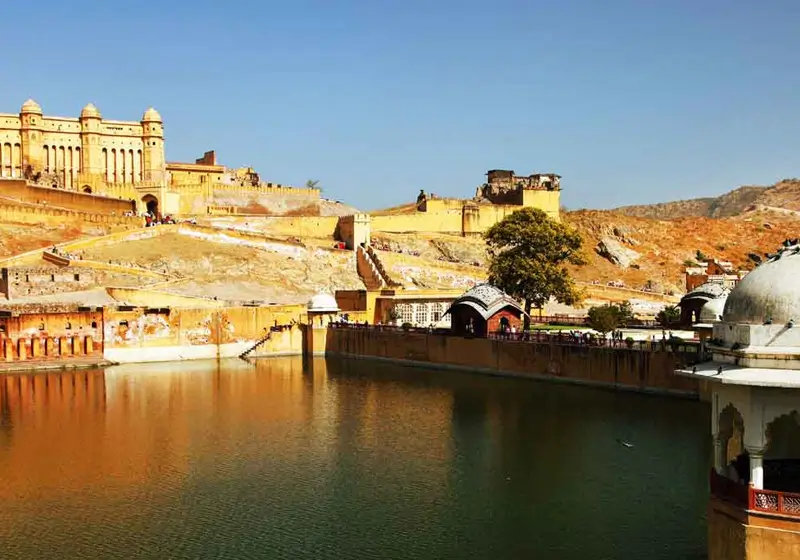
Set aside at least two weeks to immerse yourself in Indian culture by exploring the Golden Triangle, which connects the cities of Delhi, Agra, and Jaipur. Here's all you need to know about planning your vacation and local cultural traditions.
To get the best value, book three to six months in advance. Hotel reservations should also be made early to guarantee availability. While online booking is available, on-site document verification on the day of the safari might be time-consuming. Hiring an agent to handle the entire process is a convenient option that usually includes sharing a copy of your passport.
Most travelers spend three to seven days exploring the Golden Triangle, but I recommend at least a week. Chose seven nights and eight days there, and it felt like the ideal amount of time. We spent four nights in New Delhi, one in Agra, and two in Jaipur. If I had any extra days, you could probably add one to Agra to slow down the journey a little, but I didn't feel it was necessary. Seven days seems like an ideal amount of time to spend here.
Due to India's unique topography, visitors should expect varying climates throughout the country, the best time to visit Golden Triangle Tour. Summers in the north are very hot and arid, while winters are freezing. The Golden Triangle circuit is best visited between mid-September, shortly after the monsoon, and April, when temperatures can soar. Days are normally mild, but evenings may be cool, with temperatures in Delhi dropping as low as 7°C. November and February are prime tourism months, coinciding with the greatest weather and wedding season, so expect crowds and increased prices, especially for hotels.
India's festivities follow the lunar calendar, but viewing Diwali's lights and fireworks (October to November), the Pushkar Mela fair (October to November), or the colors of Holi (March) are must-sees. For wildlife enthusiasts, April and May provide the finest opportunities to see large cats.
Eating with your hands is an ancient Ayurvedic ritual that is thought to improve attention and digestion. The right hand is commonly utilized because the left is considered unclean in many faiths. Food is scooped with the fingers, then pushed into the mouth with the thumb while the palm remains clean. To eat street food safely, stick to popular vendors with high turnover, choose freshly prepared foods, avoid uncooked ingredients, and drink boiling or bottled water to avoid contamination. Observing the cleanliness practices of sellers also contributes to a safe, authentic street-food experience.
The Indian government recognises 22 official languages, the most frequently spoken of which are Hindi and English. While English proficiency in rural areas may be low, it is typically adequate for basic communication. Most tour guides are bilingual, speaking one or more foreign languages including Italian, German, Spanish, or French. Having a language translation software might also be useful.
It is critical to dress modestly, particularly at sacred sites, and to follow conventions like removing shoes and covering your head, legs, and shoulders as needed. Bargaining is typical in markets, but always be polite. Tipping is customary in restaurants, hotels, and for services, but the amounts vary – often 5-10% in restaurants and tiny change for porters and drivers.
Littering is prevalent in many places of India, however visitors should avoid contributing to the problem. Always use dustbins and dispose of rubbish properly. Seek permission before photographing individuals, especially ladies, or religious sites. Some religious and military places severely forbid photography.
ATMs and money exchange counters (which frequently accept US dollars, euros, and pounds) are widely available in large cities and are the most convenient way to receive Indian rupees. While the majority of India has adopted digital payments, and international credit and debit cards are frequently accepted, it is still necessary to carry cash when visiting tiny shops, local bazaars, or more rural locations.
This is my itinerary for my seven days in the Golden Triangle Tour:
Day 1: Arrive in New Delhi
Day 2: Explore Old Delhi
Day 3: Explore New Delhi
Day 4: Explore South Delhi
Day 5: Train to Agra; Rickshaw tour of Agra
Day 6: Drive to Jaipur, stopping at Fatehpur Sikri and Abhaneri
Day 7: Full day in Jaipur
We are delighted that you reached here.
Please share your queries with us regarding the booking tour with us.